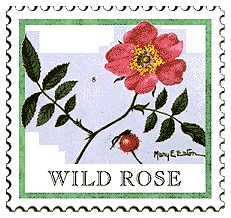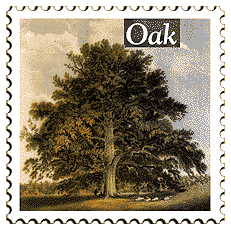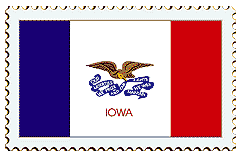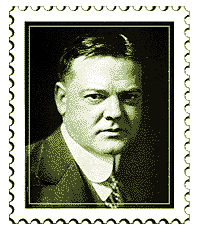
State Flower:
Wild Rose
In 1897 the Iowa Legislature designated the Wild Rose as the official state flower because it was a decoration used on the silver service the state presented to the battleship USS Iowa that same year. Although no particular species of the flower was designated, the Wild Prairie Rose is most often cited as the official flower. Wild roses bloom In various shades of pink throughout Iowa from June through late summer.

State Bird:
Eastern Goldfinch
In 1933 the Eastern Goldfinch, also known as the Wild Canary, was designated by the Iowa Legislature as the official state bird because it's common to Iowa, staying throughout the winter. The male's bright yellow body is topped in a jet black cap on his head, with black wings and a black tail. The less dazzling female has a dull olive yellow body with brown wings and tail. However, in winter months the male acquires the same dull plumage as the female.

State Tree:
Oak
In 1961 the Oak was designated by the Iowa Legislature as the official state tree because of its abundance in Iowa, and because it serves as shelter, food and nesting cover for many birds and animals. Wild turkeys, pheasants, quail, wood ducks, raccoons, squirrels, chipmunks, bluejays, nuthatches, grackles, and several kinds of woodpeckers depend on acorns as a significant portion of their diet.

State Flag:
The bald eagle, symbolizing American liberty, carries streamers with the State motto, "Our Liberties We Prize and Our Rights We Shall Maintain." The eagle and streamers are also found on the State seal.

Famous Person:
Herbert Clark Hoover
On August 10, 1872 Herbert Hoover was born in West Branch to a Quaker blacksmith. His father died when Hoover was only six years old and his uncle, a doctor, took care of him, sending him to private schools and then on to Stanford University where he studied mining engineering. After graduation he first worked underground as a miner, then as a mine surveyor in Australia before becoming a full partner in the firm. He also invested in a gold mine which brought him lifetime financial security -- all before he was 25 years old. He then went to work in China, England and Belgium. When WWI broke out, he was assigned to the Belgian War Relief, where he received worldwide acclaim for his humanitarian causes. After the war, he served as Secretary of Commerce to both Presidents Harding and Coolidge. When Coolidge decided not to run for a third term, he named Hoover his successor. Hoover began his presidency in 1929, seven months before the October 30th stock market crash leading to the Great Depression. The Depression haunted his entire term, and Hoover was blamed for all its ills. The homeless poor lived in shantytowns called "Hoovervilles;" they slept with "Hoover blankets" (newspapers), and waved "Hoover" flags (empty pockets turned inside out). For a man known for his humanitarian efforts, he was despised by the for his lack of compassion. A story goes that while walking down the street with a banker he knew, he asked to borrow a nickel to call a friend. "Here's a dime," the banker said, "call both of them."